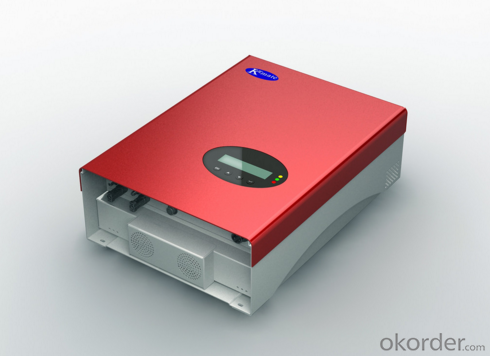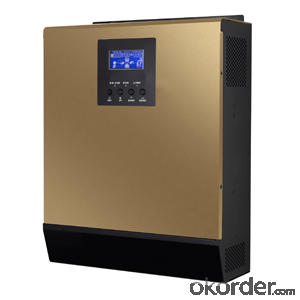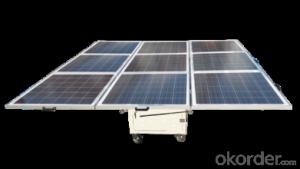Single Phase Inverter Second Generation 3.0k Solar Inverter made in China
- Loading Port:
- Shanghai
- Payment Terms:
- TT OR LC
- Min Order Qty:
- 0 watt
- Supply Capability:
- 10000 watt/month
OKorder Service Pledge
OKorder Financial Service
You Might Also Like
Description of Single Phase Inverter Second Generation 3k Solar Inverter
Solar ac power system consists of solar panels, charge controllers, inverter and battery; Solar energy does not include inverter dc power system. Inverter is a kind of power conversion device, inverter by incentives can be divided into self-excited oscillation inverter and separately excited oscillation inverter.
Features of Single Phase Inverter Second Generation 3k Solar Inverter
Standard 10 years warranty, 5-15 years optional
Built-in Gprs as option
Built-in Wifi as option
Smaller and lighter, only 9.6kg
High performance DSP for algorithm control
VDE-AR-N 4105 certification
New topology design
Dual MPPT design
Multi-button touch interface
LCD screen visible at night
Have anti-shading function
Advantages of Single Phase Inverter Second Generation 3k Solar Inverter
Longer life cycle
Plug and play
Free monitoring through our webportal
Very lower internal temperature
Easy transportation and installation
Faster CPU speed
Adjustable active and reactive power
Maximum conversion effciency up to 97.7%,Euro up to 97.0%
Real-time data readable at night
User friendly operation
Technical Data of Single Phase Inverter Second Generation 3k Solar Inverter
Type | Omniksol-3k-TL2-S |
Input(DC) | |
Max.PV Power | 3250W |
Max,DC Voltage | 500V |
Nominal DC Voltage | 360V |
Operating MPPT Voltage Range | 120-450V |
MPPT Voltage Range at Nominal Power | 150-450V |
Start up DC Voltage | 150V |
Turn off DC Voltage | 120V |
Max, DC Current | 18A/18A |
Max, Short Cicuit Current for each MPPT | 20A/20A |
Number of MPP trackers | 1 |
Number of DC Connection for each MPPT | 1 |
DC Connection Type | MC4 connector |
Output(AC) | |
Max,AC Apparent Power | 3000VA |
Nominal AC Power (cos phi = 1) | 3000W |
Nominal Grid Voltage | 220V/230V/240V |
Nominal Grid Frequency | 50Hz/60Hz |
Max, AC Current | 14.0A |
Grid Voltage Range* | 185-276V |
Grid Frequency Range* | 45-55Hz/55-65Hz |
Power Factor | 0.9 capacitive... 0.9 inductive |
Total Harmonic Distortion(THD) | <2% |
Feed in Starting Power | 30W |
Night time Power Consumption | <1W |
Standby Consumption | 6W |
AC Connection Type | Plug-in connertor |
Efficiency | |
Max,Efficiency | 97.7% |
Euro Efficiency | 97.0% |
MPPT Efficiency | 99.9% |
Safety and Protection | |
DC Insulation Monitoring | Yes |
DC Switch | Optional |
Residual Current Monitoring Unit (RCMU) | Integrated |
Grid Monitoring with Anti-islanding | Yes |
Protection Class | Ⅰ(According to IEC 62103) |
Overvoltage Category |
PVⅡ/Mains Ⅲ(According to IEC 62109-1)
|
Electricity Fuse Protection | Yes |
Reference Standard | |
Safety Standard | EN 62109, AS/NZS 3100 |
EMC Standard | EN 6100-6-1, EN 6100-6-2, EN 6100-6-3 EN 6100-6-4, EN 6100-3-2, EN 6100-3-3 |
Grid Standard | VDE-AR-N4105. VDE-0126-1-1,G83/1,EN 50438,RD1699,CEI 0-21, AS4777,C10/C11 |
Physical Structure | |
Dimensions | 343x281x150mm |
Weight | 9.9kg |
Environmental Protection Rating | IP 65 (According to IEC 60529) |
Cooling Concept | Internal fan convection |
Mounting Information | Wall bracke |
General Data | |
Operating Temperature Range | -25℃ to +60℃(derating above 45℃) |
Relative Humidity | 0% to 98%, no condensation |
Max. Altitude (above sea level) | 2000m |
Noise Type | <40dB |
Isolation Type | Transformerless |
Display | 3 LED ,Backlight, 4x20 Character LCD |
Data Communication | RS485(WiFi, GRPS integrated) |
Computer Communication | USB |
Standard Warranty | 10 Years (5-15 years optional) |
IMages of Single Phase Inverter Second Generation 3k Solar Inverter



FAQ
Q: Do you have the CE, TUV, UL Certification?
A: We’ve already passed all the tests, and any certificate is available.
Q: Have you ever sold your products to companies in my country?
A: Of course, we have customers in all general PV markets, but I think we should expand our market share along with the market growth.
Q: When did your company set up? You are a new company, how can I believe your quality?
A: We entered into Solar PV industry in 2005, now we have several plants in manufacturing of a-Si and c-Si panels, and our capacity is 220MW per year. Till now we have already passed all the tests by authorized laboratories, e.g. TUV, CE, UL.
Q: Can you help us install the module if we cooperate with you?
A: We haven’t entered into installation sector, but we have the plan in near future.
Q: How do you pack your products?
A: We have rich experience on how to pack the panels to make sure the safety on shipment when it arrives at the destination.
Q: Can you do OEM for us?
A: Yes, we can.
Q: Can we visit your factory?
A: Surely, I will arrange the trip basing on your business schedule.
- Q: Can a solar inverter be used with different types of backup power configurations?
- Yes, a solar inverter can be used with different types of backup power configurations. Solar inverters are designed to convert the direct current (DC) power generated by solar panels into alternating current (AC) power that can be used to power homes or businesses. They can be integrated with various backup power sources such as battery banks, diesel generators, or grid-connected systems. This flexibility allows for uninterrupted power supply during periods when solar energy is not available, ensuring continuous electricity supply.
- Q: What is the purpose of a solar inverter in a solar power system?
- The purpose of a solar inverter in a solar power system is to convert the direct current (DC) electricity produced by solar panels into alternating current (AC) electricity, which is the type of electricity used in most household appliances and the power grid.
- Q: Can a solar inverter be used with a solar car charging system?
- Yes, a solar inverter can be used with a solar car charging system. The solar inverter is responsible for converting the direct current (DC) produced by the solar panels into alternating current (AC) that can be used to charge the batteries of a solar car.
- Q: Can a solar inverter be used in conjunction with a smart home system?
- Yes, a solar inverter can be used in conjunction with a smart home system. The smart home system can integrate with the solar inverter to monitor and control the energy production, consumption, and storage. This allows for better optimization of energy usage, remote monitoring, and automated control of various devices and appliances within the smart home.
- Q: What is the role of a solar inverter in preventing system failures?
- The role of a solar inverter in preventing system failures is to convert the direct current (DC) electricity generated by solar panels into alternating current (AC) electricity that can be used to power homes and businesses. In addition to this conversion, solar inverters also play a crucial role in ensuring the stability and efficiency of the entire solar power system. They monitor and regulate the voltage and frequency of the electricity being generated, protecting the system from overvoltage, undervoltage, and other electrical abnormalities that can potentially lead to system failures. By constantly monitoring and adjusting the electrical output, solar inverters help maintain the health and reliability of the solar power system, ultimately preventing potential failures and maximizing the overall performance.
- Q: Can a solar inverter be used with solar-powered security systems?
- Yes, a solar inverter can be used with solar-powered security systems. Solar inverters are essential components in solar power systems as they convert the direct current (DC) generated by solar panels into alternating current (AC) that can be used to power various devices, including security systems. By using a solar inverter, solar-powered security systems can efficiently utilize the energy generated by the sun to operate and provide round-the-clock security.
- Q: Can a solar inverter be used with a generator as a backup power source?
- Yes, a solar inverter can be used with a generator as a backup power source. The solar inverter can be connected to the generator's output, allowing it to convert the DC power produced by the generator into AC power that can be used by various electrical devices. This setup enables the solar inverter to utilize the generator as an alternative power source when solar energy is not available, ensuring continuous electricity supply.
- Q: What is the role of a solar inverter in a community solar project?
- The role of a solar inverter in a community solar project is to convert the direct current (DC) electricity generated by the solar panels into alternating current (AC) electricity that can be used to power homes and businesses. It also ensures that the electricity is synchronized with the utility grid and optimizes the efficiency of the solar power system.
- Q: How does the input voltage range affect the performance of a solar inverter?
- The input voltage range directly affects the performance of a solar inverter. If the input voltage falls below the minimum range, the inverter may not be able to convert the DC power from the solar panels into usable AC power efficiently or at all. On the other hand, if the input voltage exceeds the maximum range, it can potentially damage the inverter. Therefore, it is crucial to ensure that the input voltage remains within the specified range for optimal performance and longevity of the solar inverter.
- Q: What is the role of a solar inverter in fault ride-through capability?
- The role of a solar inverter in fault ride-through capability is to ensure that the solar power system remains operational and stable during grid faults or disturbances. The inverter is responsible for detecting fault conditions and adjusting its output to mitigate the impact of the fault on the system. By providing fault ride-through capability, the solar inverter helps maintain grid stability and ensures continuous power supply from the solar panels even in the presence of faults.
Send your message to us
Single Phase Inverter Second Generation 3.0k Solar Inverter made in China
- Loading Port:
- Shanghai
- Payment Terms:
- TT OR LC
- Min Order Qty:
- 0 watt
- Supply Capability:
- 10000 watt/month
OKorder Service Pledge
OKorder Financial Service
Similar products
Hot products
Hot Searches
Related keywords




























